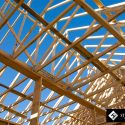Whether you’re building a new home or adding a separate structure on your property, you’ll need to decide how it will hold up the roofing system. Everything starts with the roof framework–without one, you won’t be able to have a roof installed at all. And unless your new home or addition calls for a low-slope roof, your two major choices are basically rafters and trusses. Sterling Exteriors, one of the trusted roofing companies in the area, explains the difference between the two.

Rafters
Known as ‘stick framing’, the rafters use lengthy planks that slope down from a central ridge beam at the peak of the roof. These intersect with the outside walls, forming a triangular structure. Aside from providing a sturdy foundation for your new roofing system, the rafters also offer a few distinct advantages:
- Larger attic space. The rafters can give you an expansive and unobstructed attic. This fact allows you to easily convert the space into an extra bedroom or storage area should you want to.
- More ceiling options. Vaulted or cathedral ceilings are an instant focal point in any home they’re installed in. That’s why–if you plan to integrate this design feature and make a huge difference to the look and feel of your home –you should decide on rafters as your roofing framework.
- Less Lead Time. Rafters are generally built on-site at the time of need, which means they won’t require advanced planning.
Trusses
These refer to a prefabricated wooden structure that integrates a triangular webbing of structural members. Trusses are spaced evenly from one end of the home to the opposite end, providing support for the roof overhead, while tying the exterior walls of the home together. Unlike rafters, which are done on-site, trusses are made in a factory (accurate plans with exact dimensions are submitted beforehand) and are delivered to the work area ready for installation. Here’s why you should consider trusses:
- Better quality control. Since trusses are made in a factory-controlled setting–using computer-aided saws and fabrication equipment–their quality is almost always consistent. They are even inspected and certified by third-party organizations.
- Faster installation. Once they are delivered to the worksite, trusses are prepped and ready to be installed. They are even light enough that two or three workers can lift them manually. Because of this, an entire roofing system can be trussed in just over two days.
- Greater stability. The trusses are designed to effectively distribute the weight of the roof over a wider area, thanks to the beams and ties that make up their interior triangular webbing.
As the area’s trusted roofer, Sterling Exteriors can help you decide on the roof framework that will best suit your specific needs. We serve the areas in and around Cincinnati, Loveland, and Newtown, OH. Call us today at (513) 685-8055 or fill out this contact form to schedule your roof evaluation.
